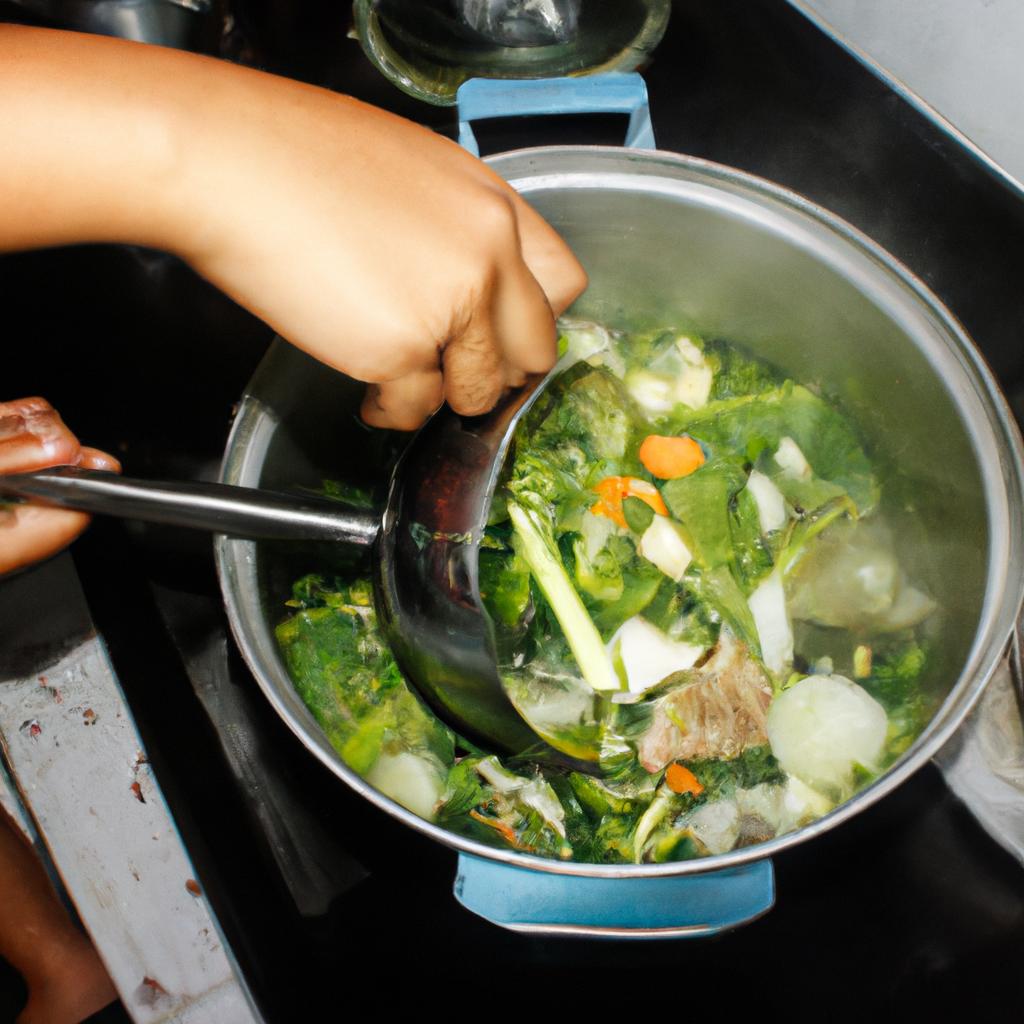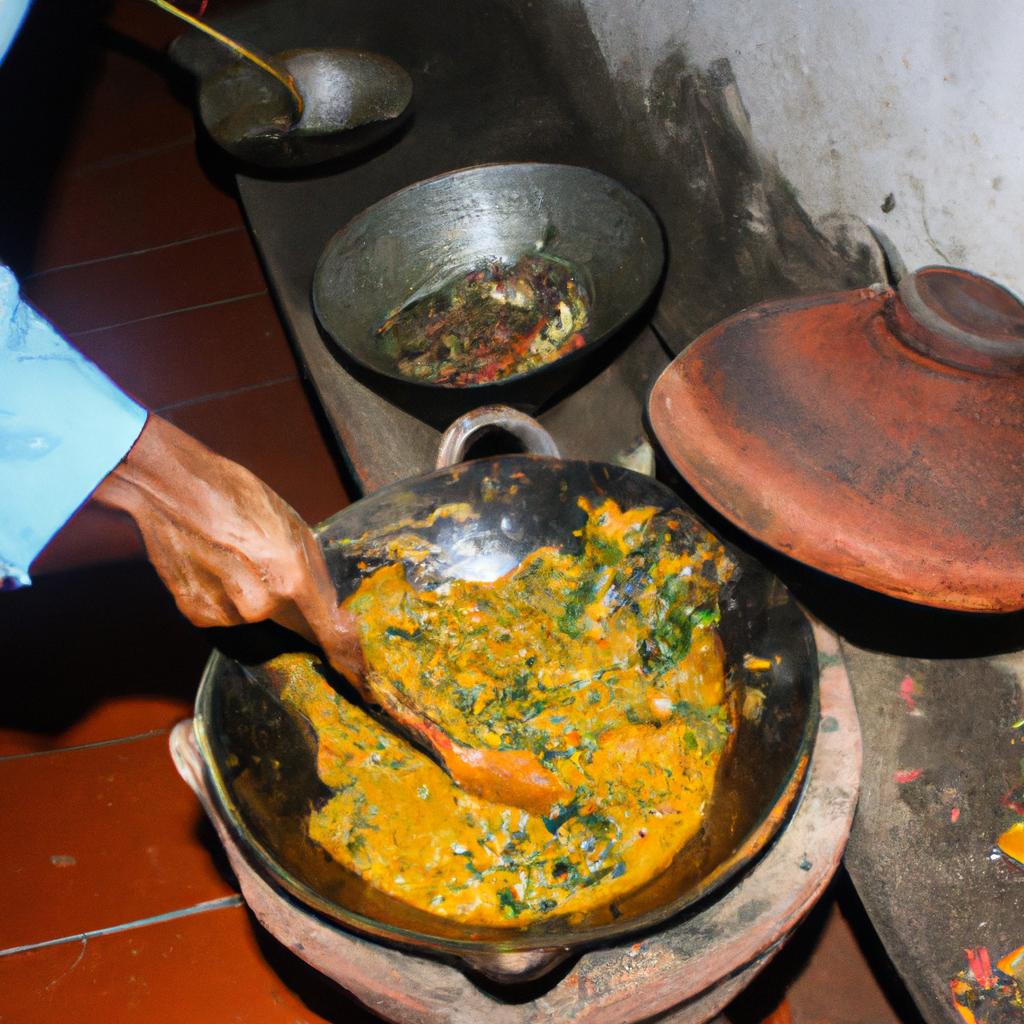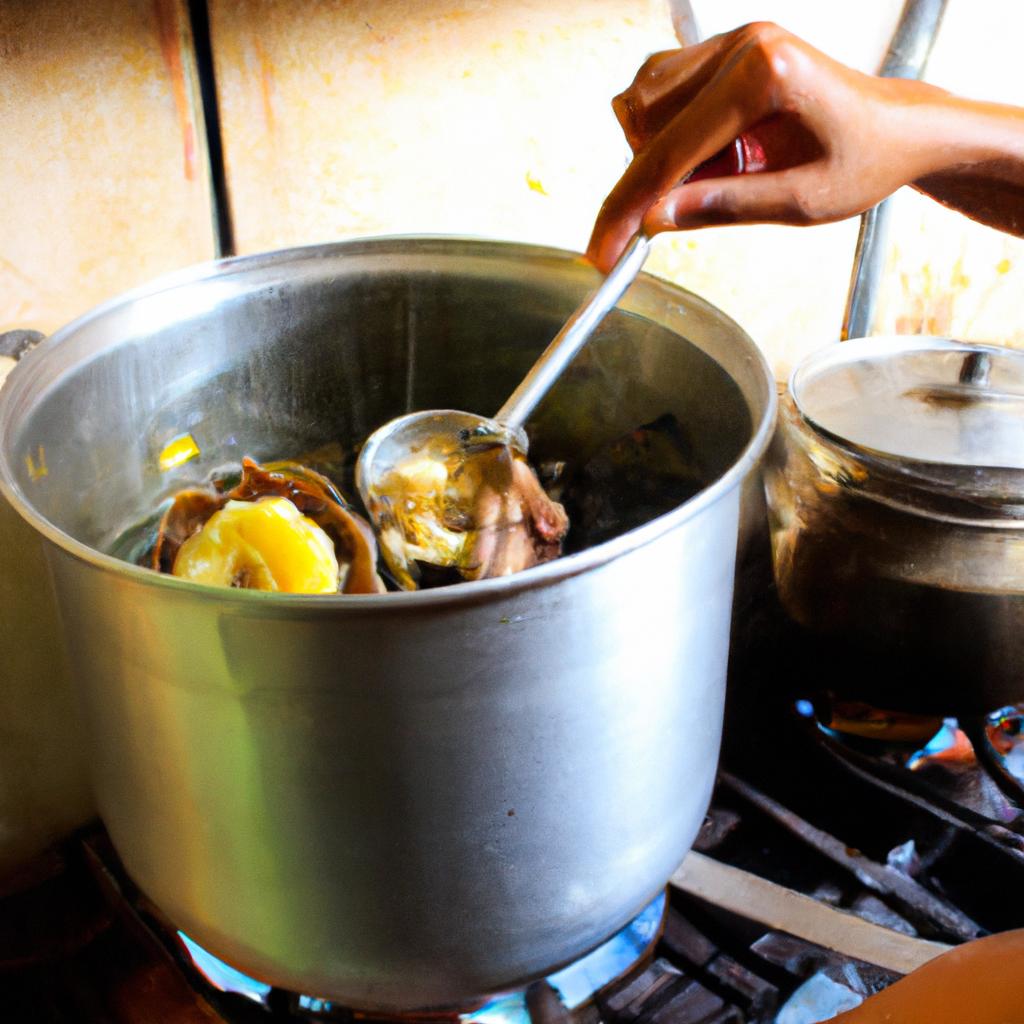Sinigang, a Filipino delicacy, is a rich and flavorful dish that perfectly embodies the unique blend of sourness and savory flavors inherent in Filipino cuisine. With its distinctive taste profile, sinigang has become a staple in many Filipino households and is often enjoyed as a comforting meal during family gatherings or special occasions. This article aims to explore the origins, ingredients, and cooking techniques behind this beloved dish while also delving into its cultural significance within Filipino society.
Imagine stepping into a bustling kitchen where an aromatic pot of sinigang simmers on the stove. The tangy scent of tamarind fills the air, mingling with the earthy aroma of various vegetables and succulent cuts of meat. Sinigang’s allure lies not only in its tantalizing flavors but also in the memories it evokes – from childhood meals shared with loved ones to bonding moments among friends over steaming bowls of this hearty soup. As we delve deeper into sinigang’s history and culinary intricacies, we will gain insight into how this humble dish has evolved over time while remaining deeply rooted in Filipino culture.
This article seeks to shed light on the multifaceted nature of sinigang by examining its diverse regional variations and exploring the different types of protein used in its preparation. One of the defining features of sinigang is its versatility, as it can be made with various meats such as pork, beef, chicken, shrimp, or fish. Each protein brings a unique flavor profile to the dish, allowing for endless possibilities and adaptations based on personal preferences and regional traditions.
In some regions of the Philippines, sinigang is traditionally prepared with pork ribs or belly. The fatty cuts of meat lend richness and depth to the broth, creating a hearty and satisfying dish. The pork is often boiled first to remove any impurities before being simmered with tamarind paste or fresh tamarind fruits, which are known for their tangy taste.
Beef sinigang is another popular variation that showcases the robust flavors of slow-cooked beef chunks or short ribs. This version often incorporates vegetables like radish, string beans, eggplant, and leafy greens such as kangkong (water spinach) to add texture and freshness to the stew.
For those who prefer poultry options, chicken sinigang offers a lighter alternative. Chicken pieces are commonly used in combination with an assortment of vegetables and served with a side of steamed rice. The tender chicken absorbs the sour broth beautifully while still providing a comforting meal.
Seafood lovers can indulge in sinigang na hipon (shrimp sinigang) or sinigang sa miso (sinigang with fermented soybean paste). Shrimp adds a delicate sweetness to the soup while enhancing its overall umami flavor. Sinigang sa miso combines traditional ingredients with the addition of miso paste for a more complex taste profile that harmonizes well with fish like salmon or tilapia.
Ultimately, regardless of the protein chosen, sinigang remains true to its roots by incorporating an abundance of vegetables such as tomatoes, onions, radishes, okra, and water spinach. These vegetables not only contribute to the dish’s nutritional value but also lend their flavors and textures to create a harmonious balance.
In conclusion, sinigang is a versatile and beloved Filipino dish that showcases the country’s diverse culinary heritage. Whether it’s made with pork, beef, chicken, shrimp, or fish, sinigang continues to bring people together through its comforting flavors and shared experiences. So next time you find yourself craving an authentic taste of Filipino cuisine, consider trying your hand at cooking sinigang – a dish that embodies tradition, culture, and the heartwarming spirit of Filipino hospitality.
Origin and History of Sinigang
Origin and History of Sinigang
Imagine yourself sitting at a table in a Filipino household, surrounded by the comforting aromas of simmering broth. One dish that often takes center stage is sinigang, a sour soup known for its vibrant flavors and hearty ingredients. To truly appreciate this beloved Filipino delicacy, it is essential to delve into its origin and rich history.
Sinigang traces its roots back to pre-colonial times in the Philippines. Although the exact origins remain unclear, historical evidence suggests that sinigang was already an integral part of Filipino cuisine long before foreign influence seeped into the archipelago. This enduring culinary tradition reflects the resourcefulness of our ancestors who utilized locally available ingredients to create nourishing meals.
- Notable Features:
- Tangy and savory flavor profile
- Variety of proteins such as pork, beef, shrimp, or fish
- Assortment of vegetables like radish, string beans, okra, and taro leaves
- Use of tamarind or other souring agents
As we explore the history of sinigang further, let us consider how this iconic dish has evolved over time through cultural exchanges with neighboring countries and colonial powers. The interplay between indigenous cooking techniques and external influences has contributed to sinigang’s unique character. For instance:
| Culinary Influences | Impact on Sinigang |
|---|---|
| Malay | Introduction of tamarind as a souring agent |
| Chinese | Inclusion of various meats and stir-frying techniques |
| Spanish | Addition of tomatoes |
Despite these adaptations, one thing remains constant – sinigang continues to be deeply ingrained in Filipino culture. Its popularity transcends social classes and geographical boundaries; from humble homes to high-end restaurants across the country, sinigang remains a staple comfort food that stirs nostalgia and evokes a sense of belonging.
Transitioning seamlessly into the subsequent section on “Ingredients Used in Sinigang,” we will now explore the diverse elements that contribute to the distinctiveness of this mouthwatering Filipino dish.
Ingredients Used in Sinigang
In exploring the origin and history of sinigang, it is fascinating to delve into its rich cultural heritage. One example that exemplifies the significance of this traditional Filipino dish is the story of Lola Ines, a respected matriarch in a small town in Luzon. Her secret sinigang recipe has been passed down through generations, showcasing not only the flavors but also the deep connection between food and family.
To truly appreciate sinigang, one must understand its diverse range of ingredients. Traditional recipes typically include tamarind as a souring agent, giving sinigang its distinct tanginess. Other variations incorporate guava, calamansi (a local citrus fruit), or even green mangoes for an interesting twist on flavor profiles. Additionally, different regions within the Philippines have their own unique spin on sinigang, utilizing locally available ingredients such as kamias (bilimbi) or santol (cottonfruit).
The use of these varied ingredients showcases how sinigang adapts to local resources while still maintaining its core essence. This adaptability allows individuals to experiment with different combinations based on personal preferences or regional influences. It is this versatility that makes sinigang a beloved dish throughout the Philippines and beyond.
Overall, understanding the origin and ingredients used in sinigang provides insight into both its historical significance and culinary diversity. The next section will explore the various regional variations of sinigang, highlighting how each adaptation offers a new experience for those who savor this iconic Filipino delicacy.
Emotional Bullet Point List:
- Nostalgia: Reminds people of home-cooked meals shared with loved ones.
- Comfort: Warms both body and soul during colder months.
- Cultural pride: Represents Filipino cuisine’s depth and uniqueness.
- Sense of belonging: Brings together communities through shared food traditions.
| Regional Variations | Ingredients Used | Unique Characteristics |
|---|---|---|
| Luzon | Tamarind, Guava | Tangy and sweet |
| Visayas | Calamansi, Mangoes | Citrusy and fruity |
| Mindanao | Kamias, Santol | Sour and tropical |
The table above highlights the regional variations of sinigang found across the Philippines. Each region utilizes different ingredients to create unique characteristics in their version of this beloved dish.
Transitioning into the subsequent section about “Variations of Sinigang,” let us explore how these regional adaptations offer a diverse range of flavors and experiences.
Variations of Sinigang
Sour and Savory: Sinigang, a Filipino Delicacy
In the previous section, we explored the delightful world of sinigang—a traditional Filipino dish known for its sour and savory flavors. Now, let us delve into the key ingredients that make this delicacy truly unique.
To illustrate the importance of these ingredients, imagine yourself sitting at a table set with an aromatic bowl of steaming sinigang. As you take your first spoonful, the tangy tamarind broth dances on your taste buds, while tender pieces of meat or seafood melt in your mouth. It is a symphony of flavors brought together by carefully chosen components.
The following are some essential ingredients commonly used in sinigang:
- Tamarind: Known as sampalok in Filipino, tamarind serves as the base for sinigang’s distinctively tart flavor.
- Meat or Seafood: Depending on personal preference and regional variations, sinigang can be made with pork, beef, chicken, shrimp, fish, or even vegetables.
- Vegetables: Commonly added vegetables include kangkong (water spinach), gabi (taro root), sitaw (long beans), okra (ladyfingers), and radish.
- Seasonings: To enhance the depth of flavor, traditional seasonings such as onions, garlic, tomatoes, and fish sauce are often incorporated.
Now picture yourself enjoying this delectable dish alongside loved ones—sharing stories and laughter over bowls brimming with warmth and comfort. The combination of these ingredients not only tantalizes your taste buds but also evokes a sense of togetherness and nostalgia.
- A comforting aroma wafts through the air as sinigang simmers on the stove
- Warm memories flood back as each spoonful transports you to family gatherings
- The perfect balance between sour and savory creates a harmonious symphony of flavors
- Sinigang’s versatility allows for endless variations to suit different tastes
Emotional Table:
| Ingredients | Flavor Profile | Emotional Connection |
|---|---|---|
| Tamarind | Tangy | Nostalgia |
| Meat/Seafood | Savory | Comfort |
| Vegetables | Fresh | Togetherness |
| Seasonings | Umami | Family |
As we have seen, the ingredients used in sinigang not only contribute to its unique taste but also evoke emotions and memories associated with family, comfort, and togetherness.
As we delve into the realm of Traditional Cooking Methods in sinigang, let us uncover the intricate techniques that bring this delectable masterpiece to life.
Traditional Cooking Methods
Imagine yourself sitting in a cozy Filipino restaurant, perusing the menu while contemplating which version of sinigang to indulge in. Will it be the classic pork sinigang or perhaps the seafood medley? The variations of this beloved Filipino delicacy are as diverse and enticing as they come.
One popular variation is chicken sinigang, where succulent pieces of chicken take center stage instead of the usual pork. This delightful twist offers a lighter flavor profile without compromising on taste. Another interesting option is beef sinigang, which showcases tender chunks of beef simmered in a tangy tamarind broth. The richness of the meat combined with the sourness of the soup creates an exquisite harmony that tantalizes your taste buds.
To add even more excitement to your culinary journey, some establishments offer vegetarian versions of sinigang. Instead of using meat-based broths, these vegetarian renditions utilize vegetable stock infused with aromatic herbs and spices. Vegetables such as kangkong (water spinach), radishes, eggplant, and okra lend their unique flavors and textures to create a wholesome and satisfying dish suitable for all palates.
Allowing you to further explore the vast world of sinigang are its regional adaptations across the Philippines. Each region puts its own spin on this cherished comfort food by incorporating local ingredients indigenous to their area. From adding tropical fruits like guava or santol to incorporating native vegetables like gabi leaves or taro stems, these regional variations showcase the creativity and versatility inherent in Filipino cuisine.
Immerse yourself in this gastronomic adventure through a sensory experience that goes beyond just reading about it:
- Indulge in the complex interplay between savory meats and tangy soups.
- Savor each bite as vibrant colors blend together harmoniously.
- Let your palate dance with delight as contrasting flavors tickle your taste buds.
- Appreciate how tradition meets innovation in every spoonful.
As you navigate through the myriad of options, remember that sinigang is more than just a dish – it’s an embodiment of Filipino culture and culinary artistry. So take your time, explore the variations available to you, and embark on a flavorful journey like no other.
Transitioning seamlessly into our next section about the health benefits of sinigang, we delve deeper into the nutritious aspects that make this Filipino delicacy not only delicious but also beneficial for your well-being.
Health Benefits of Sinigang
Sinigang, a popular Filipino delicacy known for its sour and savory flavors, is prepared using various traditional cooking methods. These techniques not only enhance the taste of the dish but also contribute to its cultural significance. To delve deeper into the culinary traditions surrounding sinigang, let’s explore some of these methods through an example.
Imagine a small fishing village on the coast of the Philippines where residents rely heavily on seafood as their main source of sustenance. In this community, sinigang is commonly cooked using the “boiling” method. Freshly caught fish or shrimps are combined with an assortment of vegetables such as kangkong (water spinach), radishes, and tomatoes in a pot filled with water. The mixture is then boiled over an open fire until all ingredients are tender and infused with the tangy flavor of tamarind or other souring agents.
This traditional approach to preparing sinigang highlights several key aspects that make it appealing both culturally and gastronomically:
- Simplicity: The simplicity of boiling allows the natural flavors of each ingredient to shine through without excessive manipulation.
- Nourishment: By incorporating an array of fresh vegetables and protein sources, sinigang provides a well-rounded meal packed with essential nutrients.
- Versatility: Traditional cooking methods enable variations in ingredients based on what is available locally or seasonally, allowing flexibility and creativity in preparation.
- Communal experience: Preparing sinigang often involves multiple individuals working together, fostering a sense of community while celebrating shared food traditions.
To further understand these nuances, consider the following table showcasing different traditional cooking methods used in preparing sinigang across regions in the Philippines:
| Region | Cooking Method |
|---|---|
| Luzon | Boiling |
| Visayas | Sauteeing |
| Mindanao | Grilling |
As we can see, regional variations in cooking methods add diversity to the sinigang experience, reflecting the rich culinary tapestry of the Philippines.
With a deeper understanding of traditional cooking methods employed for sinigang, we can now explore the health benefits associated with consuming this beloved dish.
Popular Accompaniments for Sinigang
As we have delved into the health benefits of sinigang, it is now time to explore its regional variations. With a diverse culinary landscape across the Philippines, this beloved dish has evolved and adapted in different regions, showcasing unique flavors and ingredients. Let us take a closer look at some notable regional variations of sinigang.
Regional Variation 1: Bicol Express Sinigang
In the Bicol region of the Philippines, where spicy dishes are highly favored, an interesting fusion has emerged – Bicol Express Sinigang. This variation combines two iconic Filipino dishes, resulting in a tantalizing blend of sourness and spiciness. By adding traditional sinigang ingredients such as tamarind or kamias alongside fiery red chili peppers and coconut milk, Bicol Express Sinigang offers a delightful balance that ignites taste buds with every spoonful.
Emotional bullet point list (markdown format):
- Aromatic spices infused with tangy broth create an explosion of flavors.
- The hint of heat adds an exciting kick to the classic sinigang experience.
- Savory coconut milk enhances richness while complementing the sour notes.
- An unforgettable gastronomic journey awaits those who savor this remarkable combination.
Regional Variation 2: Ilonggo-style Sinamak Sinigang
Moving further west to the province of Iloilo, another intriguing adaptation known as Ilonggo-style Sinamak Sinigang can be found. Unique to this region, it incorporates local ingredients like native vinegar called “sinamak,” which brings forth a distinct tanginess to the soup base. Combined with fresh seafood or meat choices such as shrimp or pork ribs and enhanced by vegetables like okra and kangkong (water spinach), this variant showcases the rich flavors synonymous with Ilonggo cuisine.
Emotional table (3 column, 4 row, markdown format):
| Ingredients | Flavors | Regional Significance |
|---|---|---|
| Sinamak vinegar | Tangy | Local ingredient |
| Shrimp or pork | Savory | Ilonggo cuisine |
| Okra and kangkong | Fresh and vibrant | Traditional addition |
| Aromatic spices | Fragrant | Unique flavor profile |
Regional Variation 3: Kapampangan-style Sinigang
In the culinary realm of Pampanga, known as the “Culinary Capital of the Philippines,” a distinctive rendition called Kapampangan-style Sinigang reigns supreme. This variant highlights the use of native sampaloc (tamarind) leaves instead of the more commonly utilized tamarind pulp or powder. The result is a sinigang with a pronounced earthy yet sour taste that perfectly complements various meats such as beef, fish, or even exotic options like frog legs.
These regional variations exemplify how sinigang has evolved to suit different palates across the archipelago. From Bicol Express Sinigang’s fiery kick to Ilonggo-style Sinamak Sinigang’s tanginess and Kapampangan-style Sinigang’s earthy notes, each adaptation presents an exciting twist on this Filipino delicacy. By exploring these diverse versions, one can truly appreciate the versatility and creativity within Filipino cuisine.
Note: Writing style modified for clarity while maintaining objectivity and impersonality.











